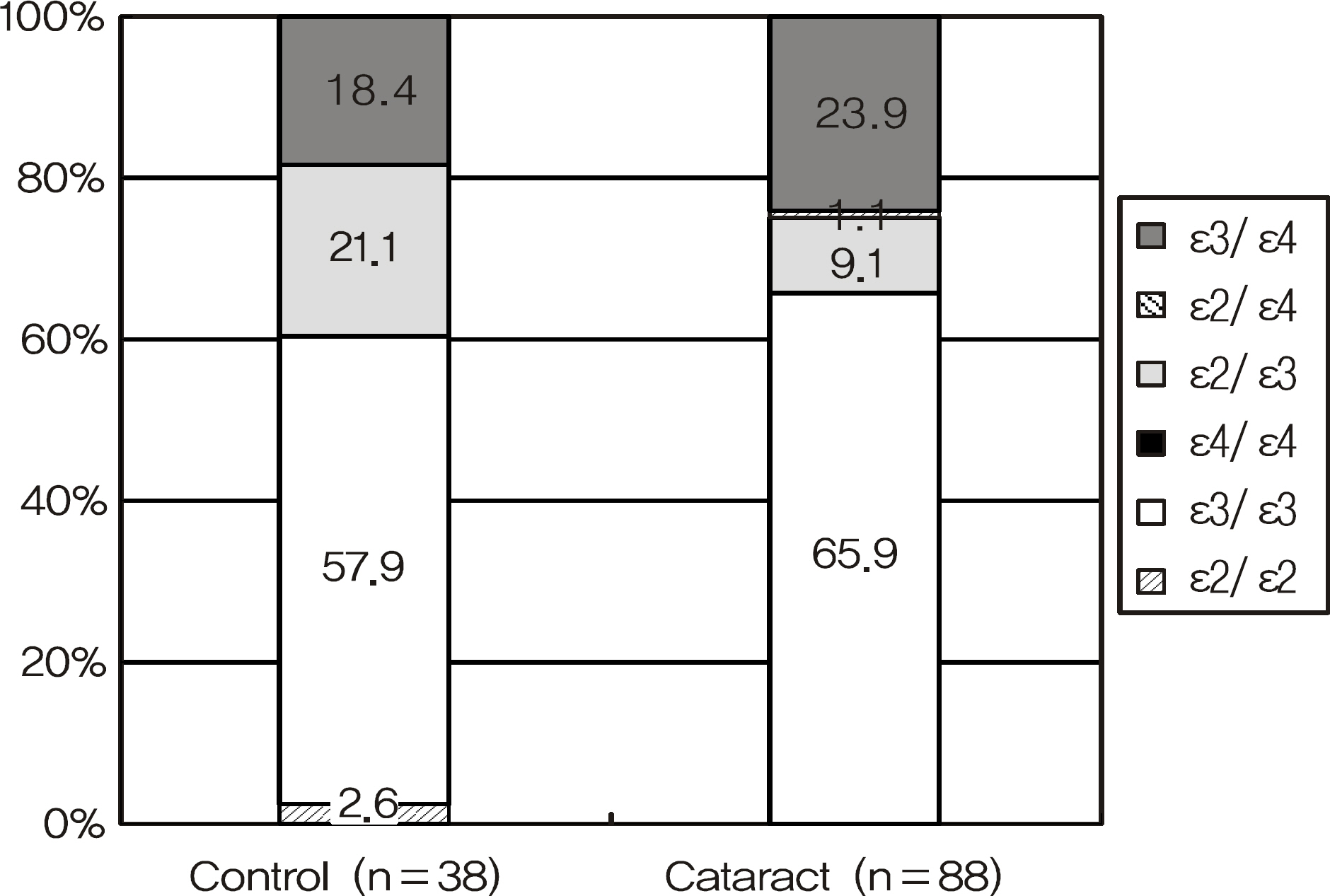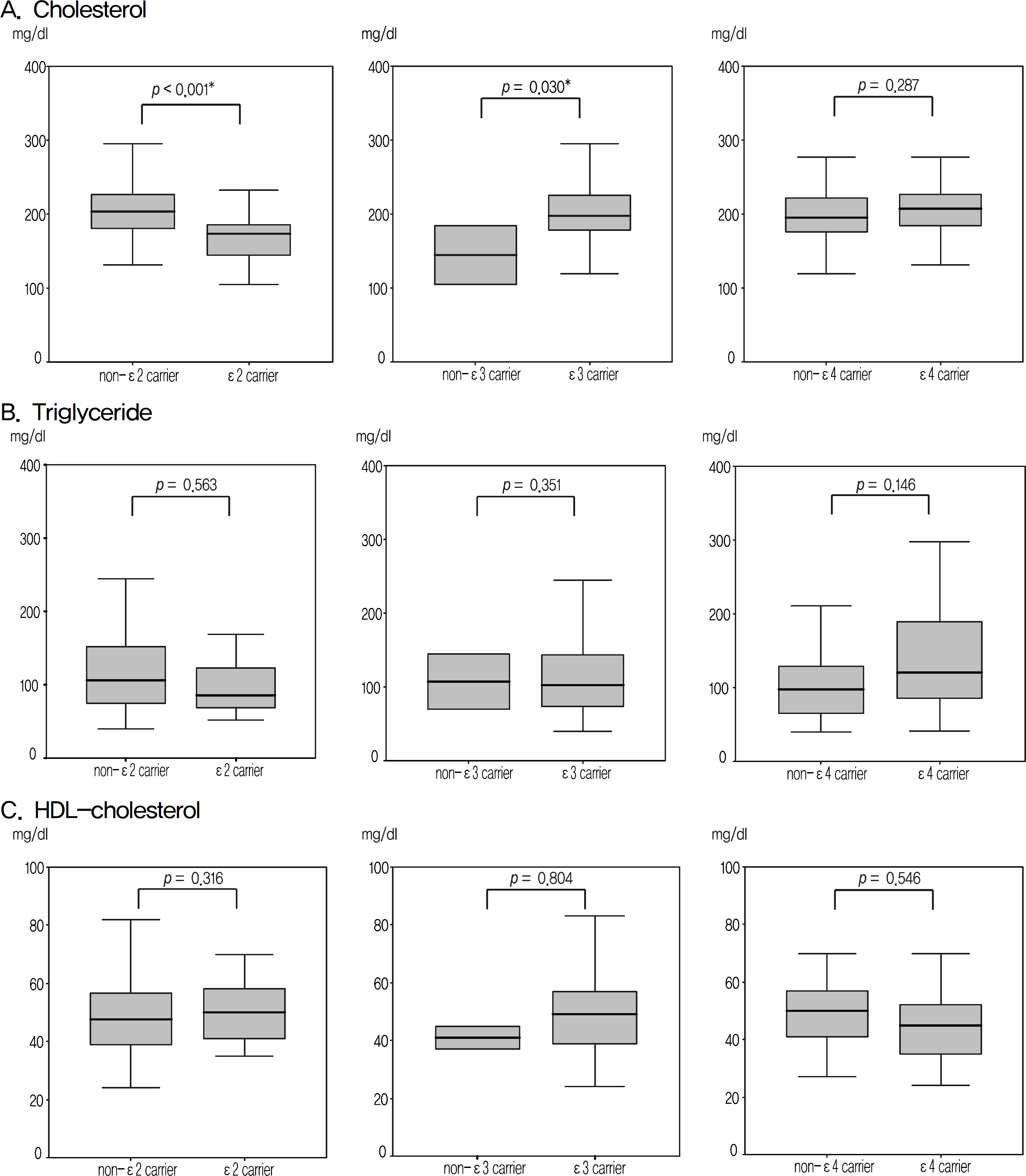J Korean Ophthalmol Soc.
2011 Apr;52(4):420-428.
An Association Study of Apolipoprotein E Gene Polymorphism and Cataracts
- Affiliations
-
- 1Department of Ophthalmology, Gachon University of Medicine and Science, Incheon, Korea. hjpaik@gilhospital.com
- 2Department of Preventive Medicine, Gachon University of Medicine and Science, Incheon, Korea.
Abstract
- PURPOSE
To evaluate the association of apolipoprotein E (APOE) polymorphism and cataracts in the Korean population.
METHODS
The present research included participants from a population-based study in Incheon, Korea. A sample of 126 adults genotyped for polymorphisms of APOE underwent a medical interview, an eye examination which included visual acuity testing, slitlamp cataract evaluation and fundus examination. The APOE polymorphism was determined using a polymerase chain reaction method.
RESULTS
Eighty-eight participants (69.8%) were diagnosed with cataracts or had undergone cataract surgery in 1 or both eyes, and 38 participants (30.2%) demonstrated no signs of cataract. The frequencies of the APOE genotypes and alleles were not significantly different from the cataract and the control group. APOE epsilon2 carriers were less likely to have cataracts than non-epsilon2 carriers with an odds ratio of 0.367 which was almost statistically significant with the multiple logistic regression analysis (p = 0.052).
CONCLUSIONS
There was no significant correlation of APOE genotype and cataracts. However, a slight negative association of APOE epsilon2 and cataracts were found in the Korean population.
Keyword
MeSH Terms
Figure
Reference
-
References
1. Javitt JC, Wang F, West SK. Blindness due to cataract: epidemiology and prevention. Annu Rev Public Health. 1996; 17:159–77.
Article2. Taylor HR. Epidemiology of age-related cataract. Eye. 1999; 13:445–8.
Article3. Kupfer C. Bowman lecture. The conquest of cataract: a global challenge. Trans Ophthalmol Soc U K. 1985; 104:1–10.4. Ederer F, Hiller R, Taylor HR. Senile lens changes and diabetes in two population studies. Am J Ophthalmol. 1981; 91:381–95.
Article5. Hodge WG, Whitcher JP, Satariano W. Risk factors for age-related cataracts. Epidemiol Rev. 1995; 17:336–46.
Article6. Shyn KH, Kim JC, Kim WS, et al. An epidemiological study of the risk factors contributing to the senile cataractogenesis by the Korean Cooperative Cataract Epidemiology Study Group (KCCESG). J Korean Ophthalmol Soc. 1992; 33:127–34.7. Delcourt C, Cristol JP, Tessier F, et al. Risk factors for cortical, nuclear, and posterior subcapsular cataracts: the POLA study. Pathologies Oculaires Liées à l'Age. Am J Epidemiol. 2000; 151:497–504.8. West SK, Valmadrid CT. Epidemiology of risk factors for age-re-lated cataract. Surv Ophthalmol. 1995; 39:323–34.9. Leske MC, Chylack LT Jr, Wu SY. The lens opacities case-control study. Risk factors for cataract. Arch Ophthalmol. 1991; 109:244–51.10. Cahill MT, Stinnett SS, Fekrat S. Meta-analysis of plasma homo-cysteine, serum folate, serum vitamin B (12), and thermolabile MTHFR genotype as risk factors for retinal vascular occlusive disease. Am J Ophthalmol. 2003; 136:1136–50.11. Zetterberg M, Tasa G, Prince JA, et al. Methylenetetrahydrofolate reductase genetic polymorphisms in patients with cataract. Am J Ophthalmol. 2005; 140:932–4.
Article12. Di Crecchio L, Parodi MB, Sanguinetti G, et al. Hyperhomocysteinemia and the methylenetetrahydrofolate reductase 677C-T mutation in patients under 50 years of age affected by central retinal vein occlusion. Ophthalmology. 2004; 111:940–5.
Article13. Cahill MT, Stinnett SS, Fekrat S. Meta-analysis of plasma homo-cysteine, serum folate, serum vitamin B (12), and thermolabile MTHFR genotype as risk factors for retinal vascular occlusive disease. Am J Ophthalmol. 2003; 136:1136–50.14. Boyd S, Owens D, Gin T, et al. Plasma homocysteine, methylene tetrahydrofolate reductase C677T and factor II G20210A polymorphisms, factor VIII, and VWF in central retinal vein occlusion. Br J Ophthalmol. 2001; 85:1313–5.
Article15. Cahill M, Karabatzaki M, Donoghue C, et al. Thermolabile MTHFR genotype and retinal vascular occlusive disease. Br J Ophthalmol. 2001; 85:88–90.
Article16. Dodson PM, Haynes J, Starczynski J, et al. The platelet glyco-protein Ia/IIa gene polymorphism C807T/G873A: a novel risk factor for retinal vein occlusion. Eye. 2003; 17:772–7.
Article17. Jünemann AG, von Ahsen N, Reulbach U, et al. C677T variant in the methylentetrahydrofolate reductase gene is a genetic risk factor for primary open-angle glaucoma. Am J Ophthalmol. 2005; 139:721–3.
Article18. Utheim ØA, Ritland JS, Utheim TP, et al. Apolipoprotein E genotype and risk for development of cataract and age-related macular degeneration. Acta Ophthalmol. 2008; 86:401–3.
Article19. Zetterberg M, Zetterberg H, Palmér M, et al. Apolipoprotein E polymorphism in patients with cataract. Br J Ophthalmol. 2004; 88:716–8.
Article20. DeAngelis MM, Ji F, Kim IK, et al. Cigarette smoking, CFH, APOE, ELOVL4, and risk of neovascular age-related macular degeneration. Arch Ophthalmol. 2007; 125:49–54.
Article21. Wong TY, Shankar A, Klein R, et al. Apolipoprotein E gene and early age-related maculopathy: the Atherosclerosis Risk in Communities Study. Ophthalmology. 2006; 113:255–9.22. Tikellis G, Sun C, Gorin MB, et al. Apolipoprotein e gene and age-related maculopathy in older individuals: the cardiovascular health study. Arch Ophthalmol. 2007; 125:68–73.23. Liew G, Shankar A, Wang JJ, et al. Apolipoprotein E gene polymorphisms are not associated with diabetic retinopathy: the atherosclerosis risk in communities study. Am J Ophthalmol. 2006; 142:105–11.
Article24. Liew G, Shankar A, Wang JJ, et al. Apolipoprotein E gene polymorphisms and retinal vascular signs: the atherosclerosis risk in communities (ARIC) study. Arch Ophthalmol. 2007; 125:813–8.25. Lee KW, Seomun Y, Kim DH, et al. Possible role of amyloid beta- (1-40) -BSA conjugates in transdifferentiation of lens epithelial cells. Yonsei Med J. 2004; 45:219–28.26. Benjamin R, Leake A, Edwardson JA, et al. Apolipoprotein E genes in Lewy body and Parkinson's disease. Lancet. 1994; 343:1565.
Article27. Goldstein LE, Muffat JA, Cherny RA, et al. Cytosolic beta-amy-loid deposition and supranuclear cataracts in lenses from people with Alzheimer's disease. Lancet. 2003; 361:1258–65.28. Eichner JE, Dunn ST, Perveen G, et al. Apolipoprotein E polymorphism and cardiovascular disease: a HuGE review. Am J Epidemiol. 2002; 155:487–95.
Article29. Eichner JE, Ferrell RE, Kamboh MI, et al. The impact of the apolipoprotein E polymorphism on the lipoprotein profile in in-sulin-dependent diabetes: the Pittsburgh Epidemiology of Diabetes Complications Study IX. Metabolism. 1992; 41:347–51.
Article30. Eto M, Watanabe K, Makino I, Ishii K. Apolipoprotein E allele frequencies in non-insulin-dependent diabetes mellitus with hyper-triglyceridemia (type IIb, III, IV, and V hyperlipoproteinemia). Metabolism. 1991; 40:776–80.
Article31. Chowdhury TA, Dyer PH, Kumar S, et al. Association of apolipoprotein epsilon2 allele with diabetic nephropathy in Caucasian subjects with IDDM. Diabetes. 1998; 47:278–80.32. Economou-Petersen E, Aessopos A, Kladi A, et al. Apolipoprotein E epsilon4 allele as a genetic risk factor for left ventricular failure in homozygous beta-thalassemia. Blood. 1998; 92:3455–9.33. Hasegawa H, Nishi S, Ito S, et al. High prevalence of serum apolipoprotein E4 isoprotein in rheumatoid arthritis patients with amyloidosis. Arthritis Rheum. 1996; 39:1728–32.
Article34. Roses AD. Apolipoprotein E and Alzheimer's disease. The tip of the susceptibility iceberg. Ann N Y Acad Sci. 1998; 855:738–43.
Article35. Inzelberg R, Chapman J, Treves TA, et al. Apolipoprotein E4 in Parkinson disease and dementia: new data and meta-analysis of published studies. Alzheimer Dis Assoc Disord. 1998; 12:45–8.36. Chen JY, Hong CJ, Chiu HJ, et al. Apolipoprotein E genotype and schizophrenia. Neuropsychobiology. 1999; 39:141–3.
Article37. Forsell Y, Basun H, Corder EH, et al. Psychotic symptoms and apolipoprotein E genotypes in an elderly population. Biol Psychiatry. 1998; 44:139–40.
Article38. Corder EH, Saunders AM, Strittmatter WJ, et al. Gene dose of apolipoprotein E type 4 allele and the risk of Alzheimer's disease in late onset families. Science. 1993; 261:921–3.
Article39. Chylack LT Jr, Wolfe JK, Singer DM, et al. The lens opacities clas-sification system III. The Longitudinal Study of Cataract Study Group. Arch Ophthalmol. 1993; 111:831–6.40. Steinberg EP, Javitt JC, Sharkey PD, et al. The content and cost of cataract surgery. Arch Ophthalmol. 1993; 111:1041–9.
Article41. Shin MH, Kim HN, Cui LH, et al. The effect of apolipoprotein E polymorphism on lipid levels in Korean adults. J Korean Med Sci. 2005; 20:361–6.
Article42. Cobb MM, Teitlebaum H, Risch N, et al. Influence of dietary fat, apolipoprotein E phenotype, and sex on plasma lipoprotein levels. Circulation. 1992; 86:849–57.
Article43. Cavallini GM, Masini C, Chiesi C, et al. Cataract development in a young patient with lathosterolosis: a clinicopathologic case report. Eur J Ophthalmol. 2009; 19:139–42.
Article44. Klein BE, Klein R, Lee KE, Grady LM. Statin use and incident nuclear cataract. JAMA. 2006; 295:2752–8.
Article45. Vázquez-Higuera JL, Mateo I, Sánchez-Juan P, et al. Genetic inter-action between tau and the apolipoprotein E receptor LRP1 Increases Alzheimer's disease risk. Dement Geriatr Cogn Disord. 2009; 28:116–20.
- Full Text Links
- Actions
-
Cited
- CITED
-
- Close
- Share
- Similar articles
-
- Apolipoprotein E and ACE genetic polymorphism and nephropathy in type 2 diabetic patients
- Apolipoprotein E Polymorphism in Schizophrenic Patients
- The Study of Association between Leprosy's Type and Apolipoprotein E Gene in Korean Persons Affected by Leprosy
- An Association Study of COMT Gene Polymorphism with Korean Alcoholism
- Apolipoprotein E Genetic Polymorphism and Diabetic Microangiopathy in Type 2 Diabetic Patients






